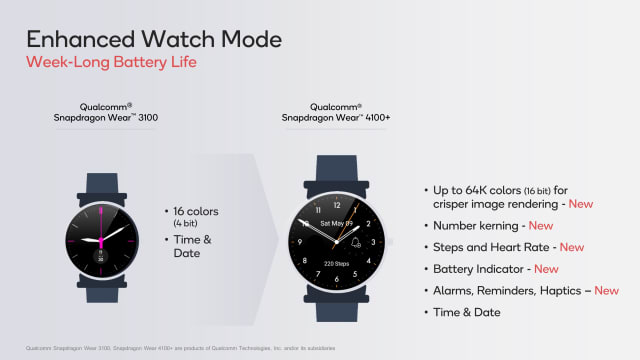The Latest Qualcomm’s Smartwatch SoC Supports 16-Megapixel Cameras
Qualcomm announced the Snapdragon Wear 3100 processor almost 2 years ago, and since then, there hasn’t really been much innovation in smartwatches, Fitbit was bought by Google, and companies continued to update their products with minor iterations, like Fitbit’s Versas, Wear OS, and Samsung’s Galaxy Watch series. Meanwhile, Apple unveiled its newest version of watchOS recently. Despite the lackluster environment, Qualcomm is continuing to innovate in the smartwatch sector. Qualcomm has unveiled a pair of SoCs (System on Chip) for wrist computers. The Snapdragon Wear 4100 and 4100+ are much faster than their predecessors. The new SoC also uses less power, providing longer battery life.
Qualcomm’s global business head for smart wearables, Pankaj Kedia, said that in comparison to the 3100, the Snapdragon Wear 4100+ will provide about 85 more performance. Like its predecessor and a lot of other ARM chips, the Snapdragon Wear 4100+ uses ARM’s big.LITTLE architecture. This time around though, the new ARM-based SoC will use a new 12 nanometer process. The Snapdragon Wear 3100 was built on 28 nanometer process, so this new chip uses significantly smaller components.
Another big upgrade is for the Snapdragon Wear 4100+ is the fact that it uses newer Cortex-A53 cores instead of the older Cortex-A7 cores found in the Snapdragon Wear 4100, and those A53 cores are running at a faster 1.7GHz clock speed in the 4100+. Also, there’s a new graphics processor, the Adreno A504 graphics engine, faster memory and two DSPs (Digital Signal Processors) instead of just one. The extra DSP is dedicated to assisting 4G LTE data connectivity. Those are a lot of changes, so the Snapdragon Wear 4100+ is going to be quite a bit faster than the 3100.

The Wear 4100’s dual ISPs (Image Signal Processors) allow for cameras that have 16-megapixels sensor sizes. Imoo, an Indonesian kids’ tech company, has announced that Imoo’s next kid-friendly smartwatch, the Z6 Ultra, will feature a Snapdragon Wear 4100. The Z6 Ultra will start shipping in the next month or so. It’s going to have a swiveling camera like a lot of the company’s other products. Also, Chinese smartwatch manufacturer Mobvoi also announced that its next Ticwatch Pro smartwatch family will use the Snapdragon Wear 4100 SoC.
Possibly the most important property of a smartwatch is how it acts when it’s just sitting there on your wrist being a watch. To provide the best watch-like experience possible, the Snapdragon Wear 4100+ includes an upgraded co-processor. Smartwatch co-processors make Ambient mode on Wear OS possible. When you aren’t directly interfacing with an android smartwatch, it goes into a lower power mode that offers fewer computer features and more of a normal watch experience. When a Snapdragon Wear 3100 went into this mode, it limited the number of colors on the screen to just 16. Now, smartwatches that use the Snapdragon Wear 4100+ will be able to show 64,000 colors while in Ambient mode. That’s a huge difference.
Always-On mode also retains the smartwatch’s ability to continuously monitor your heart rate and track your sleeping habits. Also, smartwatches using the Snapdragon Wear 4100 SoC will feature much faster tilt-to-wake functionality. A lot of other things like alarms, timers, step counting, and haptic feedback all use less power than they did on the Snapdragon Wear 3100. The small size of the transistors as a result of the new 12-nanometer process aren’t the only power-saving upgrade Qualcomm put into the Snapdragon Wear 4100+. Qualcomm went as far as to adopt an enhanced Bluetooth 5.0 architecture and low-power location tracking to reduce energy consumption by 25 percent in key use cases.
The big difference between the Snapdragon Wear 4100+ and 4100 is that the ladder doesn’t include that Always-On co-processor. So, that means that devices that use the 4100, unfortunately, won’t be able to support the Wear OS-based power-saving modes and things like sleep monitoring and continuous heart rate monitoring.
Featured Image Credit: [Qualcomm]




